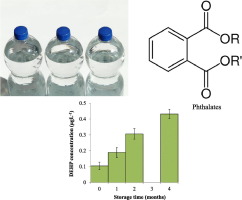Science of the Total Environment ( IF 8.2 ) Pub Date : 2017-11-08 , DOI: 10.1016/j.scitotenv.2017.10.337 Ghada Zaki , Tamer Shoeib

|
The occurrence and concentrations of six common phthalates were investigated for the first time in bottled water locally produced in the Egyptian market. The compounds investigated were dimethyl phthalate (DMP), diethyl phthalate (DEP), dibutyl phthalate (DBP), n-butyl benzyl phthalate (BBP), diethyl hexyl phthalate (DEHP), and Di-n-octyl phthalate (D-n-OP). A set of 108 bottled water samples from six different commercial brands of water bottled in transparent polyethylene terephthalate (PET) plastic bottles with high density polyethylene (HDPE) plastic caps were investigated. Water samples were analyzed immediately after purchasing (~ 2 weeks after production), after being stored at room temperature (25 ± 5 °C), in a refrigerator (4 ± 1 °C) and outdoor under sun exposure (daylight temperature of 40 ± 5 °C). Samples were stored up to six months depending on the tested condition. Among the target compounds, only DEHP and DBP were detected in the samples analyzed immediately after purchasing with a detection frequency of 50 and 58% and mean concentrations of 0.104 and 0.082 μg l− 1 respectively. Significant positive correlation was obtained between the storage time, temperature and the concentration of phthalate compounds detected in the bottled water, indicating possible migration from the PET plastic material as the source. The estimated contribution of bottled water consumption to the tolerable daily intake (TDI) levels of the two most abundant phthalates observed here for adults and toddlers did not exceed 0.16 and 0.72% for DBP while these values were 0.04 and 0.16% for DEHP respectively. These estimated daily intake values from PET bottled water consumption were far below their respective TDI values and therefore should constitute no adverse health effects.
中文翻译:

埃及瓶装水中几种邻苯二甲酸盐污染物的浓度:储存条件的影响和人体暴露的估计
首次调查了埃及市场本地生产的瓶装水中六种常见邻苯二甲酸盐的形成和浓度。研究的化合物是邻苯二甲酸二甲酯(DMP),邻苯二甲酸二乙酯(DEP),邻苯二甲酸二丁酯(DBP),邻苯二甲酸正丁酯(BBP),邻苯二甲酸二乙基己酯(DEHP)和邻苯二甲酸二正辛酯(Dn-OP) 。研究了一组108个瓶装水样品,这些瓶装水样品来自六个不同品牌的水,这些水品牌装在带有高密度聚乙烯(HDPE)塑料盖的透明聚对苯二甲酸乙二醇酯(PET)塑料瓶中。购买后(生产后约2周),在室温(25±5°C),冰箱(4±1°C)和室外暴露于阳光下(日照温度40±5)的条件下,立即对水样品进行分析。 5°C)。根据测试条件,样品最多可以保存六个月。在目标化合物中,购买后立即分析的样品中仅检测到DEHP和DBP,检测频率为50%和58%,平均浓度为0.104和0.082μgl−分别为1。在储存时间,温度和瓶装水中检测到的邻苯二甲酸酯化合物的浓度之间获得了显着的正相关性,表明可能从作为来源的PET塑料材料中迁移出来。此处观察到的瓶装水对成人和幼儿的两种最丰富的邻苯二甲酸酯的每日容许摄入量(TDI)的估计贡献对于DBP分别不超过0.16%和0.72%,而对于DEHP分别为0.04和0.16%。这些来自PET瓶装水的每日摄入量估计值远低于其各自的TDI值,因此不会对健康造成不利影响。











































 京公网安备 11010802027423号
京公网安备 11010802027423号